DIY Maintenance for Owner-Operators: Tire management
Tires are the second largest operating cost for owner-operators. Excluding your payment, tires are right behind fuel and wages in terms of per-mile cost. The exact number is tough to peg, but for big fleets it’s about a nickel a mile. For owner-ops, it’s probably closer to seven or eight cents.
We do not have good data sources to draw from in Canada, but the American Transportation Research Institute (ATRI) surveys fleets every year and reports the findings. In 2022, fleets with less than 100 trucks were paying, on average, 5.2 cents (U.S.) per mile for rubber. Fleets with 1,000 or more trucks paid 4.9 cents.
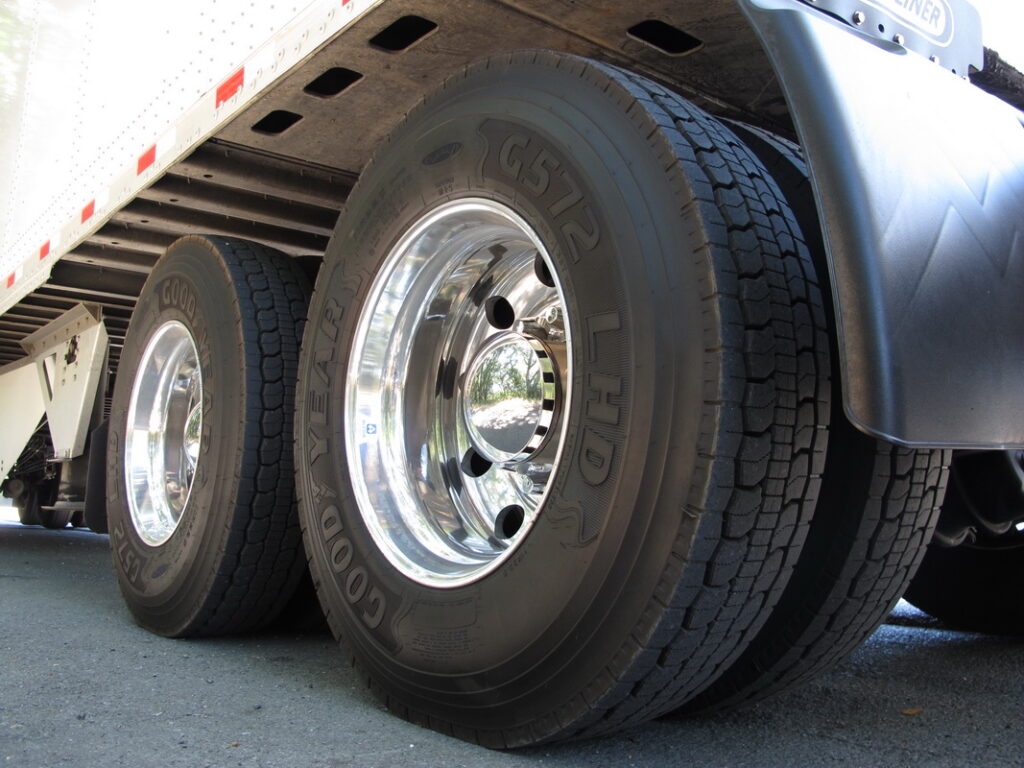
Keeping tire costs down should be a priority for small business truckers, but perhaps more of an incentive than the cost of tires is reliability. Tire-related downtime is a killer.
A roadside service call for a tire can easily exceed $1,000 between the cost of the replacement tire and the service call. And then there’s the downtime. Two to three hours is the optimistic average for big fleets with national account support. It can be considerably longer if you’re dealing over the phone with Bubba the Tire Guy.
And speaking of downtime, in 2022, the Commercial Vehicle Safety Alliance (CVSA) conducted nearly 60,000 vehicle inspections over a three-day period in the fall. Of the trucks inspected, 18.5% were put out-of-service for tire violations. Out-of-service means you don’t leave the scale until the problem is fixed. The fines and points are icing on the cake.
All that to say, wouldn’t you be better off performing regular maintenance and tire inspections than relying on good luck to keep you out of the tire shop?
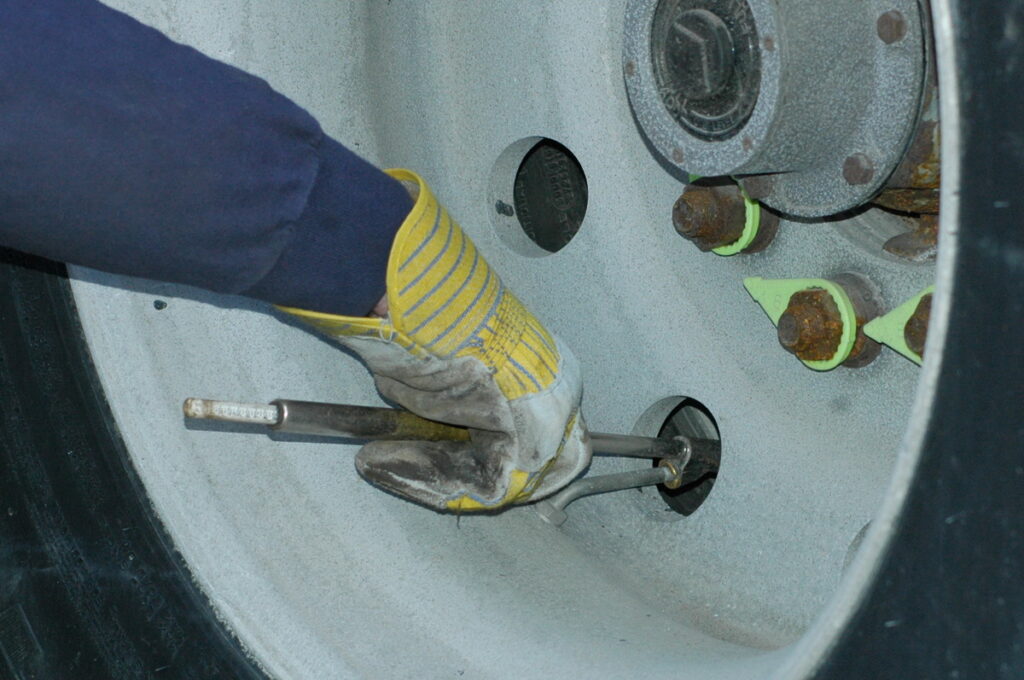
Tire inflation pressure
Regular tire inflation pressure checks, weekly at a minimum, are the fastest, cheapest, almost totally guaranteed way of preventing the leading cause of tire blowouts — underinflation. Keep in mind, you could pick up a nail which can lead to a slow leak rather than an immediate flat. Ideally, tire pressure should ideally be checked daily, but in the age of electronic logging devices (ELDs) and tight delivery schedules, that’s not entirely realistic.
Using a good quality tire pressure gauge (dual foot with 150 psi capacity, designed for truck tires costing about $20-$25), unscrew the valve cap, align the pressure foot with the valve stem and hold the gauge firmly against the valve stem so that no air escapes while checking. Record the pressure on a work sheet.
Checking inside tires in a dual assembly is inconvenient, but it’s vital that you get a good pressure reading. Statistics tell us inside tires are the most susceptible to inflation related blowouts. Because they are the most difficult to check, they often go unchecked.
Note: Always check your inflation pressure when your tires are cold. That means before driving any distance. Tire pressure can increase by about 20 psi after just 30 minutes of driving on a warm day. But don’t worry about that. Tire designers take that into account when building tires. Just remember, do not take hot tire pressure readings. Always check inflation pressure when the tires are cold.
Aperia Technologies, maker of the self-powered Halo Tire Inflator, has gathered tons of insight on inflation pressure by monitoring and analyzing customer tire data.
Aperia has found that inflation pressure in tires exposed to bright sunshine can be as much as 10 psi higher than tires on the shady side of a parked truck — or the inside tires on the sunny side of the truck.
The company has also found that tires can come up to full operating temperature within about 30 miles of driving, yet it takes about four hours for a tire to cool from hot to ambient temperature.
Tire pressure also varies with the ambient air temperature. Pressure will drop or increase about 2 psi for every 10 F change in temperature. For example, Hendrickson has charts showing pressure set to 100 psi in Miami where ambient temp is 70 F will drop to about 85 psi in Winnipeg where the temperature is 10 F. That change in cold inflation pressure is due solely to the effects of ambient temperature on inflation pressure. The air inside the tire expands and or contracts when it is heated or cooled. Heat causes an increase in pressure; cooling causes pressure to drop.
All that to say, always check your inflation pressure when the tires are cold, i.e., undriven for at least four hours, and when one side of the truck hasn’t been sitting in direct sunshine for several hours.
What inflation pressure?
Industry practice, or maybe it’s just tradition, suggests that 100 psi is the de facto tire pressure setting for all tires. But that number isn’t based on data or fact. According to the tire manufacturers’ Load and Inflation Tables, drive or trailer tires at 100 psi are overinflated for the most common applications.
An adequate pressure setting for most tires under typical Canadian and American loads would between 85 and 90 psi. There are several advantages to this, as we discussed in a previous article from April 2021, including more even tread wear, lower susceptibility to punctures, and improved traction. We wrote about two fleets’ successful experience with lower inflation pressures in that article.
Dual tires
For optimal tire life, the difference in pressure between tires in a dual assembly should be no greater than 5 psi. Even that small a difference can affect the overall circumference of the tire. This has the effect of scrubbing tread rubber off the tire with the smaller circumference (the lower-pressure tire).
For the same reason, it’s important that both tires in a dual assembly be exactly the same height when mounted on the truck. It’s not necessarily the depth of the tread that matters, but the overall height of the tires when mounted on a wheel. Mismatches will result in the shorter of the two tires wearing faster than the taller tire. The height difference between the shorter and taller tires should be no more than 2/32nds to 3/32nds of an inch.
Steer tires are another matter.
Depending on the tire size and the actual load on the steer axle, inflation pressure might need to be as high as 120 psi.
Inflating tires to 100 psi may have been okay 20 years ago when 12,000-lb. steer axles were common, but it’s not enough anymore. Steer axles in many modern trucks with setback axles are now rated for 13,000 or 14,000 pounds, and they are almost always loaded right to the max.
Steer tires must be capable of supporting that weight. First, make sure you are using steer tires that are rated for the load they carry, and then, make sure they are properly inflated. Here’s how common tire sizes and inflation pressures stack up, according to commercial tire Load and Inflation tables. These are published on every tire maker’s website, or your dealer can provide them.
The table below shows common tire sizes and their maximum loads (single) at a given inflation pressure. For example, a 275/80R22.5 (load-range G) inflated to 100 psi can support 5,780 lb. So, two of those on a steer axle will support a load of only 11,560 lb. At 110 psi, the tires will support 12,350 lb.
If you have a higher rated steer axle, 13,200 for example, you need a tire capable of at least 6,610 lb. Depending on the tire, that could mean inflating it to 120 psi.
Also, take note of the maximum inflation pressure for your tires. It’s noted on the sidewall of the tire.
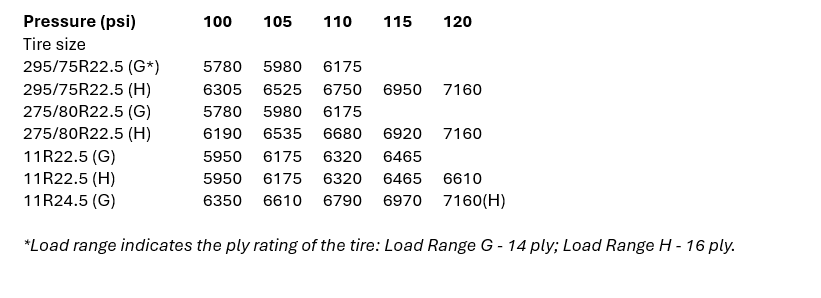
Getting back to the 100-psi question, steer axle loads on the longnose conventionals seldom exceed 12,000 lb. in normal on-highway service, so 100-psi inflation pressure might be adequate with those trucks. Set-back steer axles shift a larger percentage of weight forward thus increasing steer axle loads. And all that emissions hardware adds another thousand pounds or so to the truck. Much of that winds up on the front axle.
Mike Beckett, the American chassis alignment guru and president of of MD Alignment in Des Moines, Iowa, gets a close look at trucks and their tires every day. He sees a shocking number of trucks coming through his shops with low-pro 22.5 LRG tires inflated to 100 psi on even 13,200-lb. axles.
“The heavy steer axle is there for a reason,” Beckett says. “The manufacturer knows the front end of the truck is heavy, so they use an axle capable of carrying the weight. Often, those axles are loaded up to pretty close to that rating, so we know the tires are supporting close to 13,000 lb. or more. Yet, the tires on the axle at 100 psi are rated for no more than 11,500 or 11,600 lb. If those axles are loaded, those tires could be running 1,000 or 1,500 lb. each over their rated maximum capacity.”
Or viewed from another angle, the tires may be underinflated by 15 to 20 psi.
You can check the steer axle weight rating of your trucks. It’s shown on a sticker usually located in the left-hand door post.
If you’re experiencing poor life from your steer tires, or worse, frequent blowouts, you may be running underrated steer tires for the loads on your steer axle, or they may be grossly underinflated.
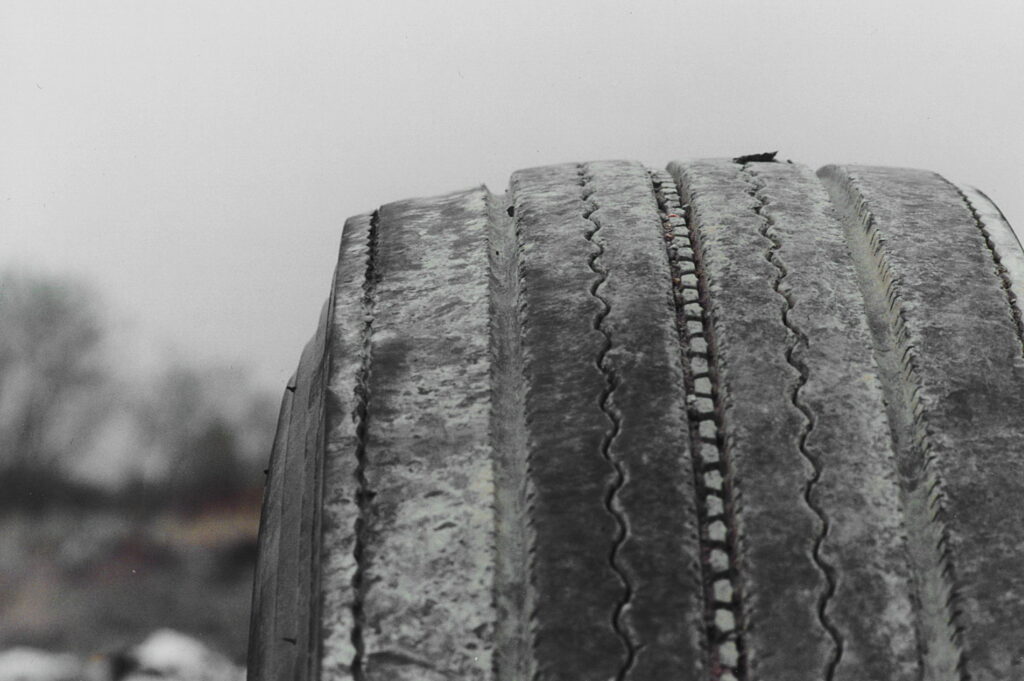
Irregular tread wear
Unless your truck is equipped with cheap-ass, poor quality tires, you can be reasonably sure that any irregular wear you’re experiencing is not the fault of the tire itself. Most likely the wear is the result of some mechanical shortcoming or irregularity on the truck. Possible culprits include bad alignment, loose or worn steering or suspension components, bad shocks, etc.
There are literally dozens of common or typical tire wear patterns to be concerned about. If you spot irregular wear appearing on your tires, get to a dealer as soon as possible, identify the root cause of the wear, and deal with it. If you catch it quickly, you’ll save the tire.
There’s no point in replacing a badly worn tire without first eliminating the source of the wear. Do that and you’ll soon destroy the new tire as well.
Here are just a few of the really common types of irregular wear you’re likely to see (Source: TMC Radial Tire Wear Conditions and Causes: A Guide to Wear Patterns Analysis):
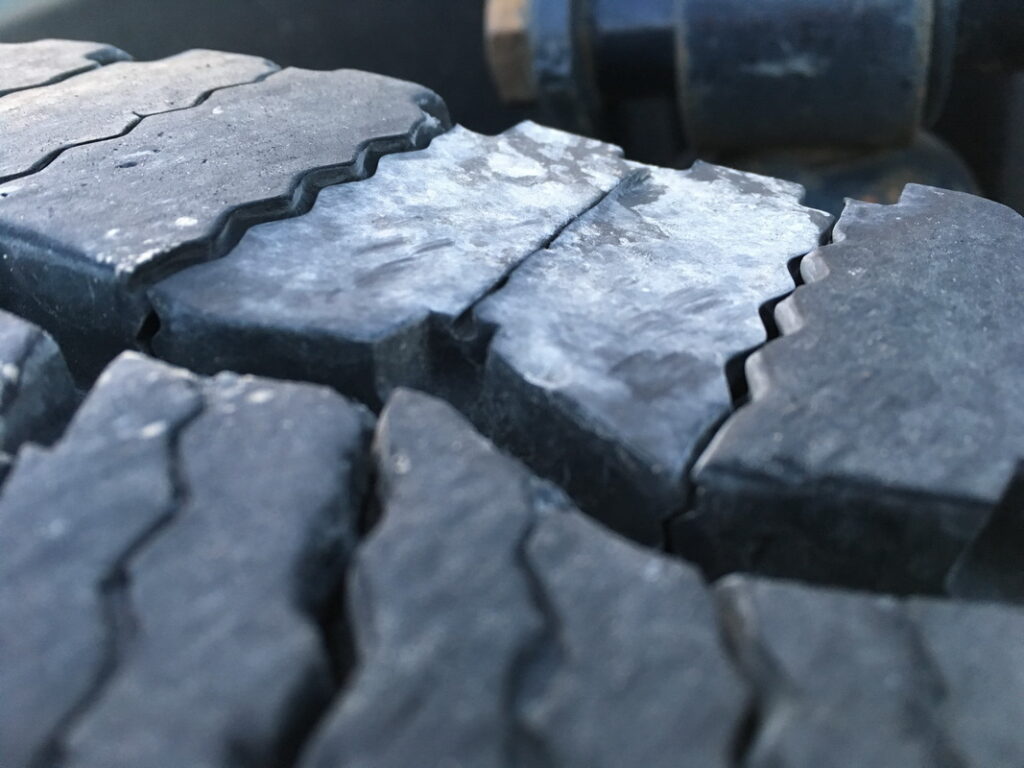
Drive tires:
Excess wear on alternate lugs: Often caused by mismatched inflation pressure or tire diameter in dual assemblies, bad shocks, or high-torque operation.
Rapid shoulder wear on one shoulder: Could be caused by scrubbing from tight turns, negative camber induced by axle flex or misadjusted wheel bearings.
Rapid shoulder wear on both shoulders: Usually caused by overinflation or being lightly loaded.
Heel-to-toe wear, drive tires: Lugs on drive tired are worn high-to-low, front-to-back. Often caused by mismatched inflation pressure or tire diameter in dual assemblies.
Steer tires:
Shoulder wear extending across to a major tread groove: Generally caused by steer or drive axle misalignment, or poorly maintained suspension components.
Feather wear where treads are worn high-to-low across each rib: Generally caused by excess scrubbing resulting from misalignment.
Erosion or river-wear: Circumferential wear along rib edges next to major tread groves. This is a normal condition on some makes of tire, caused normal driving with infrequent turning, as in an on-highway operation.
Cupping/scallopping or wavy wear: Usually caused by moderate to severe out-of-balance condition or non-concentric mounting of the tire/wheel assembly. Possibly from back shocks or loose kingpins.
Casing and tread damage
Inspect the whole tire for damage, including both sidewalls, the shoulder and bead areas, and the tread face. Look for cuts or slices in the sidewalls or areas where the inner cords are exposed. Also check for foreign objects in the treads, like nails and screws.
Watch for lumps or bulges in the sidewalls. This could indicate internal damage.
Some of the alignment related wear (damage) can be felt more easily than seen. Run the palm of your hand across the tread face. It should feel smooth to the touch, but heel-to-toe wear will feel like little ridges against your hand when rubbed in one direction but not the opposite direction.
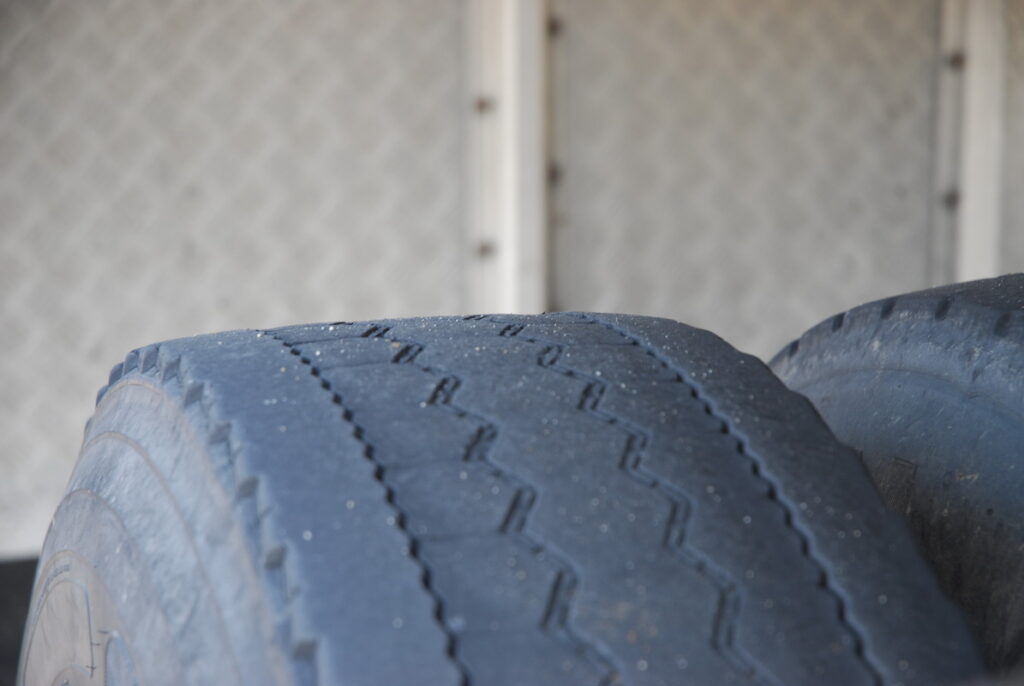
Common Out-of-Service conditions
The Commercial Vehicle Safety Alliance has established certain conditions that will place a tire out of service. Keep a close eye on your tire condition so you aren’t sidelined with an expensive repair/replacement. Follow these guidelines when inspecting your tires:
- Maintain adequate tread depth: minimum of 2/32nd of an inch on steer tires, and 1/32 on drive tires. That’s about bald. Never allow your tread to get that low.
- Watch for areas where belt material or casing ply is showing on the tread face or sidewall due to cuts or abrasions.
- Watch and listen for audible air leaks. A tire with less than 50% of the max pressure indicated on the sidewall is considered flat and will be put out of service.
These are out-of-service conditions, by the way, not minimum maintenance standards.
Ease the tire maintenance burden
Tires are not cheap, so there’s a clear return on the investment you make in maintenance. Here are a few investments that can make the task a little easier without cutting corners.
An aftermarket tire pressure monitoring system: Without all the telematics and data reporting capabilities, these systems can be quite affordable. They give you an instant alert if your tire pressure falls below a pre-set threshold. This is a surefire way of preventing blowouts related to underinflation. Even with a TPMS installed, inflation pressure should still be manually checked at least once a week.
Dual tire pressure equalization systems: Systems such as the Dual Dynamics Crossfire system or the Cat’s Eye system from Link Mfg., equalize the pressure between two dual tires while providing a visual indication of the inflation pressure. There are no electronics involved and installation is dead simple. These devices offer protection against underinflation, protecting four drive positions for less than the price of one cheap drive tire.
The Halo Tire Inflation system from Aperia Technologies: This is a self-powered tire inflation device that works with drive and steer tires. Halo maintains a pre-set inflation pressure using a small pump inside the device driven by the motion of the wheel. No motor, no electrical connections and no plumbing into the air system on the truck.
Up next in our owner-operator’s DIY maintenance series: Chassis maintenance, featuring greasing and lubrication guidelines, suspension inspections and a DIY alignment check.
Have your say
This is a moderated forum. Comments will no longer be published unless they are accompanied by a first and last name and a verifiable email address. (Today's Trucking will not publish or share the email address.) Profane language and content deemed to be libelous, racist, or threatening in nature will not be published under any circumstances.
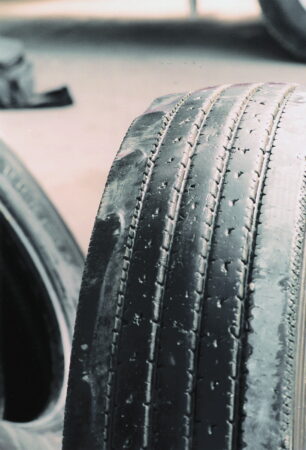
Good Article but I don’t see any mention of a rotation program.
It can save a lot of money especially on multi axle trailers.